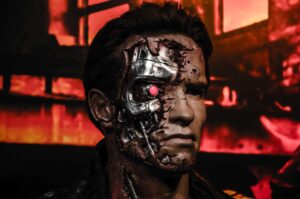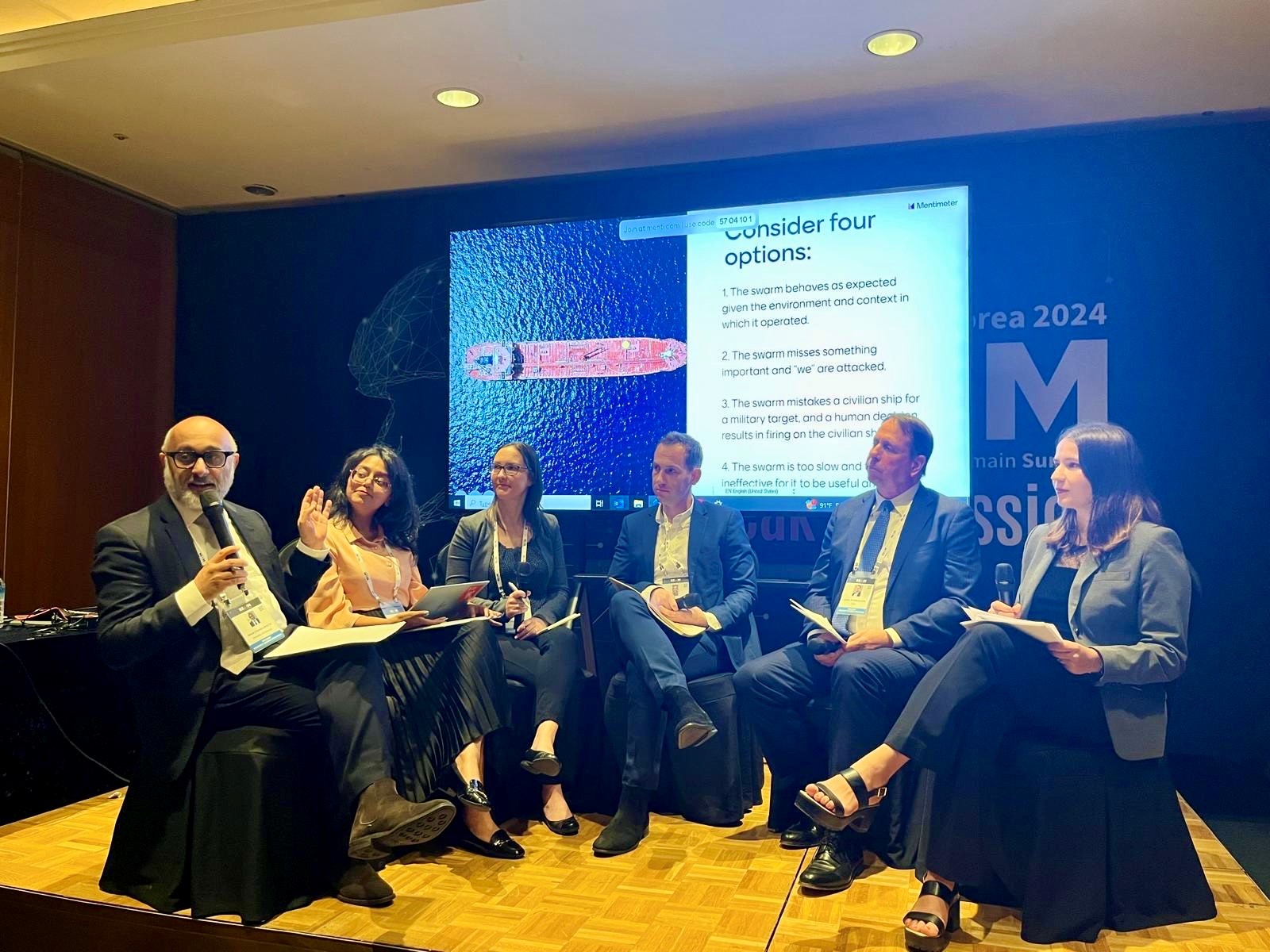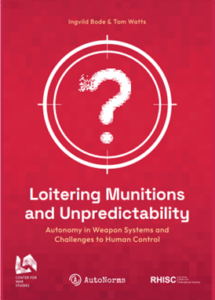Whilst the depiction of weaponised artificial intelligence (AI) technologies in popular culture is often highly inaccurate and dramatized, Hollywood blockbusters provide the starting point from which many members of the public begin to develop their thinking about these technologies. For instance, news articles discussing AI are often accompanied with images of metallic silver skulls with red eyes and headlines such as “Indestructible Terminator-style killer robots move one step closer to reality as scientists discover self-healing metals“. In these and other ways, the various types of stories told about AI in popular culture have real-world implications for the ongoing political debates about weaponised AI. As some researchers suggest, an awareness of stories featuring intelligent machines may “form the backdrop against which AI systems are developed, and against which these developments are interpreted and assessed”. Released in late September 2023, The Creator is a recent example of a Hollywood blockbuster film featuring AI. This film provides a useful case study for reflecting on the various factors which may influence the cinematic depiction of these technologies and how these may be changing over time.
At its core, The Creator is a cinematic exploration of a clash between optimistic and pessimistic thinking about AI: a broad set of technologies which, as understood by American defence planners, refers to the “capability of computer systems to perform tasks that normally require human intelligence”. The film presents an imagined future in which the United States—and the “West” more broadly—has declared a global war on AI associated technologies following a nuclear attack on Los Angeles. Thereafter, the United States bans all domestic uses of AI and, from what can be inferred from the film, reorders its foreign policy around eliminating the global use and development of AI associated technologies. In this way, The Creator presents a twist on the trope featured in many popular culture franchises including The Terminator. Rather than AI setting out to destroy its human creators; humans set out to destroy their technological creations. The Creator therefore resembles the themes of Ridley Scott’s 1984 film Blade Runner—a comparison reinforced in the film’s retro-futuristic design and acknowledged by its director, Gareth Edwards.
The Creator’s release coincides with Hollywood’s increasing interest in AI as both a narrative plot device and as a point of dispute in the recently ended Writers Guild of America strike. The film has been interpreted by commentators as presenting a philosophical examination of “whether an artificial intelligence can ever truly be sentient” and a possible “vision of AI backlash“. Building on some of the themes of recently published co-authored research on the first two Terminator films, this piece has a different focus. Drawing from the study of AI narratives as pioneered by researchers including Stephen Cave, Kanta Dihal and Sarah Dillon, it reflects on what The Creator tells us about the various types of stories told about intelligent machines and how such stories may be influenced by changing global geopolitics, as well as discusses why these stories matter for the international debates on weaponised AI.
Stories about intelligent machines in Western popular culture
The depiction of various forms of intelligent machines in literary works long predates the international debates on emerging technologies in the field of lethal autonomous weapon systems which began during the mid-2010s. To help better understand the popular depiction of these technologies, researchers at the Leverhulme Centre for the Future of Intelligence have developed the study of AI narratives. AI narratives can be broadly defined as the stories told about intelligent machines. According to these researchers, AI narratives can be both “fictional (speculations in popular contemporary science fiction, and the long history of imaginative thinking about intelligent machines) or non-fictional (science communication about AI, and media coverage of AI science and technology and its effects)”.
Stephen Cave and Kanta Dihal have catalogued eight of the most common AI narratives featured in Western popular culture through a survey of 300 fictional and non-fictional works. They identify two broad sets of stories featuring these technologies: those that are “hopeful” that developments in artificial intelligence will have a positive effect on humanity and those that are “fearful” that it will not. “Hopeful AI” narratives present intelligent machines as a transformative cause of human immortality, ease, and gratification, and as a vehicle for preserving the dominance of certain utopian ways of life. “Fearful AI” narratives, in contrast, explore the idea that AI will trigger inhuman behaviours, produce human obsolescence and social alienation, and be the catalyst of a machine uprising in which these technologies overthrow their human creators. As Cave and Dihal understand it, the fear that machines will “rise up” and attempt to destroy their creators can be traced to an anxiety that humans will lose control over the decisions taken by AI.
A summary of the AI narratives identified by Stephen Cave and Kanta Dihal is provided in the table below. By re-examining the depiction of what political scientist Charli Carpenter labels the ‘Good Terminator’ featured in Terminator 2: Judgement Day, my recently published co-authored article with Ingvild Bode highlights the value of broadening this categorisation of AI narratives to include a “hopeful” set of stories about what we coin “machine guardians”. These stories feature the depiction of anthropomorphized forms of AI that, like Arnold Schwarzenegger’s ‘Good Terminator’, protect humans from physical harm, follow instructions, and can use force with superhuman levels of accuracy.
The various AI narratives present in Western popular culture have at least three sets of real-world implications. First, US defence officials have publicly spoken about grappling with the “Terminator conundrum” produced by recent advances in AI. Recent research suggests that popular culture can function as “rhetorical repertoires” which are “use[d] to explain the stakes, risks, and military uses of AI”. Second, popular culture references also feature in the informal conversations between participants at the UN Convention on Certain Conventional Weapons which has been meeting since 2014 to discuss the possible global governance of emerging technologies in the field of lethal autonomous weapons systems. At these debates, and possibly elsewhere, popular culture can serve as a form of “social currency” which can help individuals navigate and promote conversations regarding these technologies. Third, whilst acknowledging that audiences can infer different meaning from the same work of fiction, popular culture also appears to influence how Western publics think about artificial intelligence. For example, Stuart Russell, a prominent researcher and public commentator on these technologies, has called on journalists to “stop using this image [of the Terminator] for every single article about autonomous weapons”. As he notes, “[t]his Terminator picture is wrong for so many reasons […] it makes people think that autonomous weapons are science fiction. They are not. You can buy them today”.
What stories does The Creator tell about intelligent machines?
Central to The Creator is an imagined clash between “hopeful” and “fearful” visions of the future of AI development. Contrary to the optimism which underpins much American thinking about technology, the film’s dramatic tension comes from the US fighting an overseas war to destroy AI development labs. In the fictional country of New Asia which includes the present-day Thailand and Vietnam, US forces fight what could be described as an “over-the-horizon” military campaign centered around the use of special operation forces and airpower to hunt down and destroy AI research labs. At multiple points in the film, US policymakers and soldiers justify this hypothetical conflict through use of “fearful” AI narratives: namely, that the United States must destroy all forms of AI before an AI “uprising” destroys humanity.
The citizens of New Asia—the fictional country at the forefront of this conflict—are presented as approaching AI in fundamentally “hopeful” terms. Humanoid robots are integrated throughout New Asia’s society, appearing to play a prominent role in the economy, policing, and religious ceremonies. These technologies are presented as providing various forms of “ease” and “gratification”. This includes the depiction of one machine character as a “messiah figure” seemingly created to end all war. In a theme recently explored by the Global AI Narratives Project led by Cave and Dihal, in this way, The Creator examines different imagined cultural understandings of the desirability of developing and using AI.
According to Gareth Edwards, one of the biggest differences between how AI is presented in The Creator when compared to other Hollywood blockbusters is its more ‘human’ depiction of these technologies. Extras in The Creator were not told whether their characters would be presented as humans or AI systems in the film’s cinematic release. The filmmaker said he “wanted the Al to feel very human [because], [b]asically, the AI in our world believe that they’re real”. Whilst conflating algorithmic and human forms of agency, this decision was consistent with what Edwards has described as his broader narrative vision for The Creator:
The obvious starting point of this film was that AI was the bad guy. But whether it’s science fiction or a contemporary war movie, everyone always wants to see things from their own perspective. And the second you look at things from AI’s perspective, it flips very easily. From AI’s point of view, we are attempting to enslave it and use it as our servant and definitely not treating it as an equal with any rights at all. So we’re clearly the baddie in that situation. It was impossible to see it from that perspective and not go down that path. […]
The stories about intelligent machines featured in The Creator also speak to the broader relationship between geopolitics and popular culture—a subject which has invited debate on the representation of the Cold War and the Global War on Terror in Western film and television. This topic is deserving of further discussion, particularly from a post-colonial perspective. Gareth Edwards was partially inspired to make The Creator after travelling around Vietnam. According to Edwards,
My experience of Vietnam prior to this [trip] was through the movies like Apocalypse Now (1979) and Platoon (1986). I’m looking at all this crazy war imagery in terms of how I’m recalling it. I’m picturing everything with robots in it […] I felt, this is interesting, you could take the science fiction thing and bring it to the paddy fields of Vietnam. I’ve not seen that. Picturing that kind of warfare but with robots.
What is also noteworthy about The Creator’s visual references to the Vietnam War is how they are combined with a portrayal of certain aspects of the United States’ more recent counterterrorism operations. The analogies between the war fought by the US against AI in The Creator and the Global War on Terror declared by the George W. Bush administration in the aftermath of the 9/11 attacks were intentional. As stated by the film’s director, “In the eyes of the West in our movie, [AI] is public enemy number one… It’s like Osama bin Laden, ‘We want them dead'”. As the United States continues to reorganise its foreign policy around the principle of strategic competition with the “pacing challenge” of China and links its development in AI associated technologies to Chinese military modernisation, The Creator thus also invites further reflection on how changes in global geopolitics may influence how autonomous weapon systems are presented in popular culture.
James Cameron, director of the first two Terminator films, for example, has reported first becoming aware of geopolitics during the Cuban Missile Crisis. According to Cameron, this event prompted the “sudden sensation that my coddled existence was a façade. Something dark and terrifying lurked behind it”—themes explored cinematically in The Terminator (1984). This film, Cameron has claimed, was
born out of the science fiction movies and literature I grew up with. For the most part, they were warnings—about technology, about science, about the military and the government. You couldn’t escape those themes or the fear of nuclear holocaust.
Why do the stories told about intelligent machines in popular culture matter?
The implications of advances in AI associated technologies for the conduct of algorithmic warfare is subject to growing academic and policy debate. Speaking in 2017, then US Deputy Secretary of Defense Bob Work remarked that in addition to changing how wars are fought, he was “starting to believe very, very deeply that [AI] is also going to change the nature of war”. Published in June 2023, the annual update on the US Marine Corps’ Force Design 2030—a politically contentious set of modernisation efforts intended to enable the service to better fight in the Indo-Pacific—similarly stresses that, whilst ensuring that such technologies do not replace human decision making, “Marines must fight at machine speed or face defeat at machine speed”.
Whether advances in AI associated technologies will revolutionise warfighting or change the nature of war remains debated. As Jack McDonald suggests, weaponised AI could prove to be somewhat of a “washout“. Despite the immense financial investments being made globally into the development of increasingly autonomous weapons systems, perhaps “[m]ilitary AI will automate some bits of warfare, but probably not most of them”. Indeed, in an action reminiscent of the videogame Metal Gear Solid, a pair of US Marines reportedly tricked an AI trained to identify humans during one DARPA experiment by hiding under a cardboard box.
As headlines such as “Metal Gear Solid was a documentary: soldiers use cardboard box to sneak past AI” suggest, public thinking on these technologies is unlikely to be informed by a careful reading of academic research, defence planning documents, or the statements made by politicians. Rather, it is more probable that popular thinking on the appropriateness of incorporating greater levels of AI onto the battlefield will come from films like The Creator and other forms of popular culture including videogame franchises such as Metal Gear Solid. Rightly or wrongly, popular culture provides the point from which many begin to think about weaponised AI. Whilst recognizing that depictions of these technologies in popular culture are highly dramatized, they need to be taken seriously, and debated alongside the various ethical, legal, and strategic implications of AI development. Moving forward, more research is needed into the various stories told about intelligent machines in film and television and their possible relationship to global great power competition.














